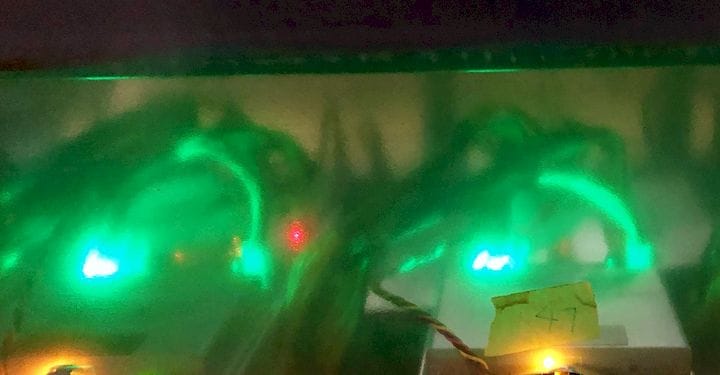![CLF controllers during metal 3D printing operations [Source: Fabbaloo]](https://fabbaloo.com/wp-content/uploads/2020/05/image-asset_img_5eb09a1591542.jpg)
We’ve been working on a secret project for some time now, and today we reveal our new development.
It’s no secret that the business of 3D printing news reporting is not the most lucrative operation possible, so we have long been seeking additional sources of revenue. With our extensive knowledge of the industry, we know that currently the most profitable segment of 3D printing is metal 3D printing.
The reasons for this are simply that metal 3D printers produce more production-ready parts instead of prototypes, and there are a lot more production parts required worldwide. There are significant advantages available to 3D printed metal parts, as they can take on unusual geometries unachievable with traditional metal-making processes.
Thus two years ago we began development of a revolutionary new metal 3D printing process in our underground lab. It was an enormous amount of work, but we persevered and today are ready to release some details on our project.
We’re not simply announcing yet another powder bed/laser metal 3D printer, as so many companies have done. Those products offer little advantage over mature equipment already in the market. No, we’re focusing on solving one of the most nefarious issues in metal 3D printing: warping.
The tremendous heat employed in most metal 3D printing processes today is able to form the parts from fine metal powder, but the massive heat travels through the part during and after printing and very frequently causes distortions in shape due to unequal thermal flows.
To overcome this issue most professional metal 3D printing operations employ squads of thermal engineers and metallurgists to carefully design metal 3D print jobs to minimize this effect. Sometimes they are successful, and sometimes not. Often it requires many iterations to discover the best configuration, wasting precious engineer time and expensive metal powder in the process.
![Microscopic view of the CLF array system [Source: Fabbaloo]](https://fabbaloo.com/wp-content/uploads/2020/05/fabbfab-microscopic-1_result_img_5eb09a15e15f2.jpg)
Our design attacks this problem directly by changing the process and eliminating thermal effects entirely.
The key to our technology is our newly developed and patent-pending “Cold Laser Fusion” (CLF) engine, which replaces the powerful and hot laser components found in other competing power bed / laser fusion metal 3D printing options.
![Backside of the CLF array driver [Source: Fabbaloo]](https://fabbaloo.com/wp-content/uploads/2020/05/image-asset_img_5eb09a164d8f8.jpg)
The patent-pending CLF technology permits fusion of metal powder without any thermal effects. This means that metal 3D printing operators would be able to freely set up print jobs with any geometry and orientation, as there are no longer any thermal concerns.
![Early and overly simple 3D printed metal part made on a prototype CLF system [Source: Fabbaloo]](https://fabbaloo.com/wp-content/uploads/2020/05/image-asset_img_5eb09a168e70c.jpg)
Due to the low temperatures involved, CLF is able to achieve high parallelization by tightly weaving an array of CLF laser drivers. We expect this array configuration should allow CLF to produce metal objects far more rapidly than any other conceivable metal 3D printing process.
Another very useful side effect of CLF is that due to the low temperature of the laser system, there is no requirement for an oxygen-free build chamber, which in traditional hot metal 3D printers prevents explosions from occurring. CLF systems simply require an air-sealed chamber to keep the workshop tidy.
But a process is nothing unless it is practically available. That is solved by our project, which has developed an entire 3D printing system around the CLF technology concept. We’ve created a new line of CLF-based powder bed devices we call “FabbFab”.
![FabbFab Model F logo [Source: Fabbaloo]](https://fabbaloo.com/wp-content/uploads/2020/05/image-asset_img_5eb09a16c7c5c.jpg)
FabbFab is envisioned to be a series of devices of varying build dimensions with increasingly powerful features as we release them over the next few years. For now, we are focusing on the first device in the FabbFab line, the Model F.
![Flow shunt component for the FabbFab F [Source: Fabbaloo]](https://fabbaloo.com/wp-content/uploads/2020/05/fabbfab-connector-1_result_img_5eb09a1712446.jpg)
FabbFabb F is targeted as a demonstration machine, suitable for use by research facilities or educational institutions seeking an inexpensive approach for experimenting with different powder materials. The build volume will be approximately 180 x 180 x 150 mm. While CLF was intended for use with fine metal powder, it may also be possible to use the system with thermoplastics, clays or even cereals.
The advantages of CLF are enormous: 3D print services currently employing engineers no longer require their services, and operations could be staffed by operators with less than high school equivalent education.
Of course, this is a pre-announcement; the FabbFab F will not be available until our expected release date of 2020Q1, and we will open pre-orders sometime before that date. Our apologies for the lack of specific details in this post, but our intention is to deliver more details leading up to the full release of FabbFab F.
We’re very excited about FabbFab and CLF, as it could be the very future of metal 3D printing. We’re hoping you’re just as excited as we are!
Do you want an F?











